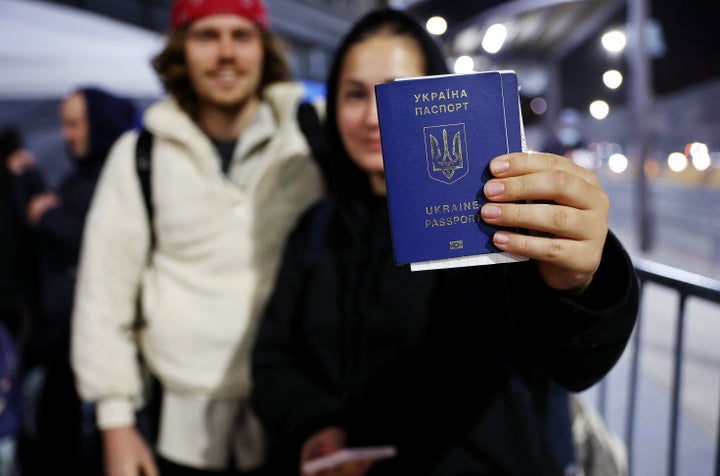
The Biden administration’s new program to admit refugees from Ukraine could face the same processing struggles that have plagued efforts to welcome Afghans and other refugees, immigration experts warned after the program was announced on Thursday.
The new plan, called Uniting for Ukraine, will allow U.S. citizens and groups to financially sponsor people fleeing Ukraine to come to the U.S. The goal is to admit 100,000 of about 5 million people who have fled since Russia invaded their country in February.
U.S. officials said the program is also intended to deter Ukrainians from traveling to Mexico to attempt to enter the U.S. via the southern border. Around 15,000 undocumented Ukrainians have arrived during the last three months, mostly at the U.S.-Mexico border, senior administration officials told reporters on Thursday.
The application process for the new program will be “fairly quick” — about a week for clear-cut applications, The Washington Post reported, citing a senior administration official.
While immigration and refugee advocates applauded the goal of the program, past efforts to expand refugee admission to the U.S. suggest it won’t be so simple to bring in 100,000 Ukrainians.
“The administration is saying they expect these cases to be decided within a week — I think that’s very ambitious,” said Theresa Cardinal Brown, Bipartisan Policy Center’s managing director of immigration and cross-border policy. “I hope they’re right, but I’m currently skeptical.”
The streamlined process, set to launch on April 25, will rely on a humanitarian parole program, a tool mostly used for urgent humanitarian reasons or significant public benefit. It allows certain Ukrainians who have sponsors in the U.S. to enter and stay for two years without having to seek a visa or go through backlogged refugee procedures.
Humanitarian parole has been previously used in crisis circumstances to resettle Vietnamese in 1975 and Iraqi Kurds in 1996. More recently, it was used to relocate and resettle tens of thousands of Afghans in the wake of the 2021 U.S. withdrawal from Afghanistan and the Taliban’s takeover of the country.
Afghan refugee resettlement was supposed to be accelerated, too — but it hasn’t turned out that way.
In September, the Biden administration introduced humanitarian parole as a tool for speeding up the relocation of at-risk Afghans who were left behind by the U.S. pullout. However, U.S. Citizenship and Immigration Services has struggled to keep up with a surge in applications that is 20 times larger than the total number of applications it receives in a typical year, Al Jazeera reported. The process has stalled after almost seven months.
U.S. Citizenship and Immigration Services told Al Jazeera in February that of more than 40,000 Afghan humanitarian parole applications filed since July 2021, it had denied 930 and conditionally approved just 160. The overwhelming majority have yet to be processed, and the agency offered no timeline for their completion.
The refugee resettlement process as a whole was significantly damaged by the Trump administration, which attempted to slash U.S. efforts to welcome people fleeing other countries.
Biden announced a goal of admitting 125,000 refugees this fiscal year, but the U.S. is nowhere near doing so. Only 8,758 refugees have been admitted in the first six months of the current fiscal year, according to State Department figures. Prioritizing applications from Ukraine could put unprocessed cases at the bottom of the pile.
“It’s not like there is excess capacity in the U.S. government, sitting around doing nothing that can now be applied to process these new applications,” Brown said. “Everybody is fully occupied processing the existing applications. And we know we have backlogs.”
The Ukrainian program does have some unique aspects. Unlike Afghan evacuees who have been paroled into the United States without sponsors and were resettled through resettlement agencies, the new program requires Ukrainians to have an individual or group in the United States that’s willing to sponsor their arrival.

Sponsorship is intended “to provide the initial financial and other support that will help Ukrainians integrate and regain their footing here in the United States,” said Nazanin Ash, CEO of Welcome.US, a refugee group encouraging Americans to sponsor Ukrainians refugees.
“We have far more capacity as a nation,” Ash said. “And we are tapping into the goodwill of a much broader range of American institutions and American people.”
A YouGov poll conducted for Welcome.US shows that 72% of Americans, including Republicans, Democrats, and independents, support the United States welcoming Ukrainians fleeing the war. About 90 million American adults are already taking part in helping Ukrainian refugees settle in the U.S., or would like to, the survey found.
But the government’s ability to process applications quickly could be an issue, Ash said.
Once sponsorship is approved, Ukrainians will receive travel authorization to the United States and will be considered for parole only after they undergo vaccinations and other public health requirements, pass rigorous biometric and biographic screening, and are vetted in security checks.
“I am concerned that that is going to be a potential constraint on people fleeing Ukraine being able to find safety quickly,” Ash added.
Even after arrival in the U.S., Ukrainians are likely to face even more backlogs in the immigration system. While parole allows for temporary lawful presence, it does not confer immigration status and does not provide a path to lawful permanent residence. Once here, however, refugees could apply for asylum.
“What’s going to happen when that temporary status expires?” Melanie Nezer, senior vice president at HIAS, a refugee resettlement organization, told The Washington Post. “There is a concern that this would just add to the undocumented population here if Congress doesn’t act.”
Ukrainians will be eligible for work authorization once paroled through this process, but that could take months, Brown said.
Meanwhile, refugee organizations want similar protections for other refugees from around the world who have fled violence and persecution, including those who have left their homes in Cameroon, Ethiopia, and Mauritania, as well as tens of thousands more Afghan allies who were left in their country.
Ash said she hopes the U.S. can replicate quicker processing for other refugees, too.
“The U.S. government recognized that we needed a rapid mechanism for people to be able to come to safety,” Ash said. “These are really important innovations that now we need to standardize, replicate, and recognize for all refugee populations.”
